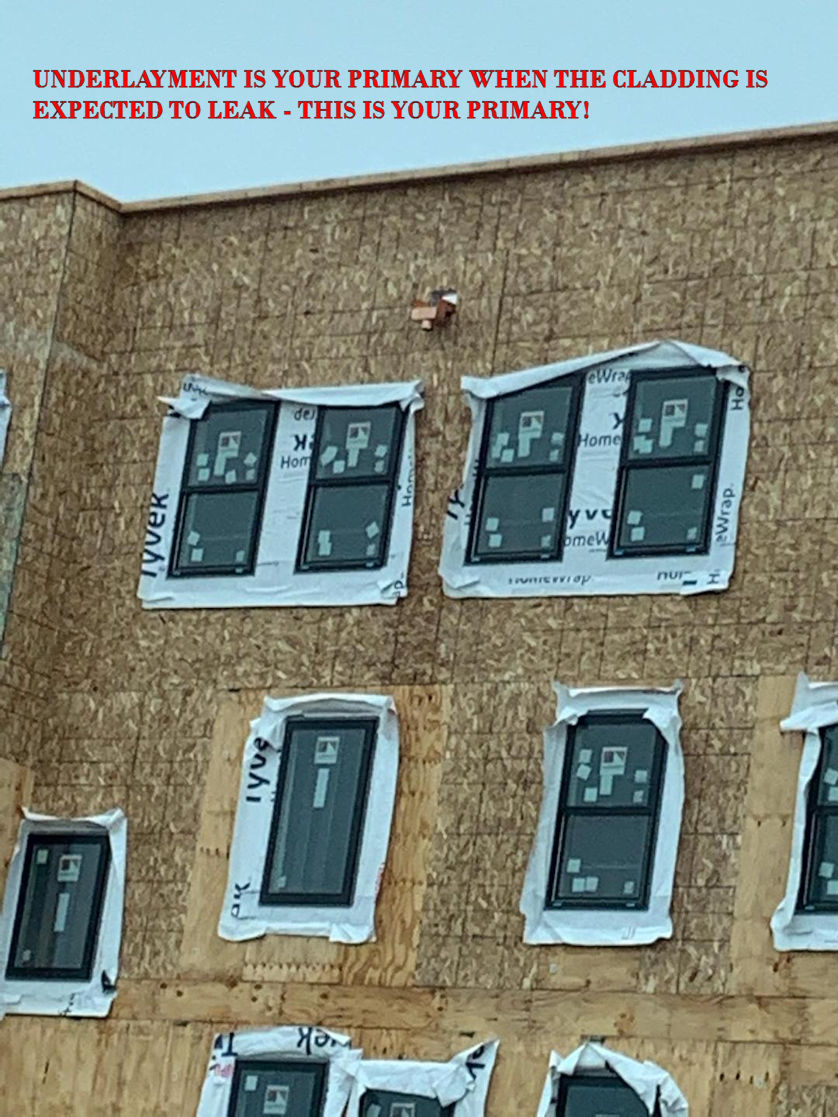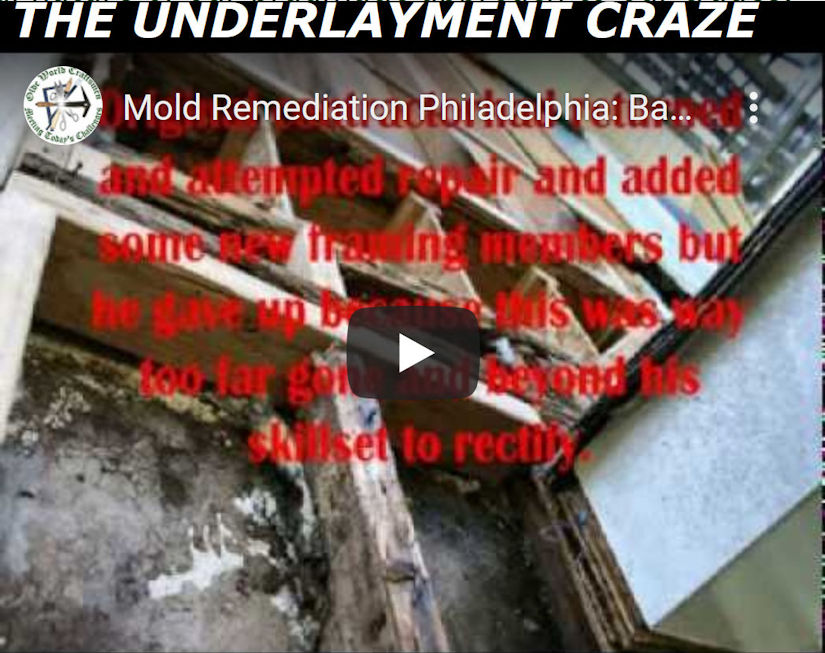

2018 - CELLEBRATING 40 YEARS!
WALL CLADDING - SIDING SHOULD NOT LEAK!
UNDERLAYMENT IS NOT A PRIMARY UNLESS YOUR SIDING OR STUCCO IS EXPECTED TO LEAK. THIS IS SERIOUS!
The exterior cladding industry has lost its soul to the "UNDERLAYMENT CRAZE" and the damage is showing itself in the discovery of MOLD and Rot. The video linked above serves as a warning to the industry and consumers.

STUCCO LEAKS - VINYL SIDING LEAKS AND THEY ARE EXPECTED TO LEAK!!!! WHERE DOES THAT LEAVE US? YOUR LEAKING EXTERIOR CLADDING IS MERELY A BATTEN SYSTEM TO HOLD YOUR UNDERLAYMENT!
"Band-Aide"
Roofers & Siders
The enigma comes in with the transient nature of the industry
and the employment of techniques that are improper. Roofing
flashings are usually laborious to replace properly and
almost always neglected. Ice and Water underlayment is also
being used on low sloped applications, where shingles should
not be specified. With a strong underlayment, an actual
flashing leak can be disguised for several years. The leak,
while unnoticed by the building owner, is poised to present
a major problem down the road. The mentality that ice &
water underlayment is the cure-all is just wrong. The only
time the underlayment should be wet is in the event of catastrophic
weather conditions. Read below for
the Siding applications that are taking place in today's
marketplace that are fully expected to leak.
Some Older
Craftsmen Angry
Many of the more seasoned craftsmen of the trade have an
axe to grind about Ice and Water underlayment. The driving
force behind the obvious angst felt by these artisans, most
certainly, must have its roots in the new age of inexperience
mentality that raises Ice and Water underlayment to the
stature of a roofing system, in and of itself. As
mentioned above, there are roofers that use a
“Band-Aide” approach to roofing with the underlayments.
When installing roofing, after the underlayment has been put into place, the thought of the underlayment ever catching water should never enter the roofer’s mind. In the contemporary mind set, sadly it does, and the material is being used as a primary waterproofing membrane in some installations. This is the peeve of the guys that pick up the pieces each day of shoddy workmanship! In the old days, these thoughts would never enter the mind of a roofer. His roof was the primary waterproofing membrane, plain and simple. A leak was a leak and no underlayment would ever be used in place of good roofing craft details.
Underlayments - Use Behind Siding
A better example of the compromised values of the
industry cannot be found: Variations of these sticky
bituminous products are being used behind Siding. Vinyl
Siding, in particular, is known to allow moisture to enter
behind it. These membranes and several variations thereof
are openly advocated by the industry ‘experts’ to be used as
primary waterproofing agents. Terms such as "Flashing" are
liberally being given to these membranes. Never have
underlayments been so formidable. House-wraps and siding
underlayments are being touted as the answer to leaking
siding. These new underlayment products are permeable for moisture
migration, but with the creation of a new dew point, perm
rates mean little. Old craftsmen have always
viewed underlayments as temporary. Now, they are widely
viewed as part of a "system." A group of manufacturers have
now given the designation of “Supplemental Rain Screen,” to their products.
A Siding product being viewed as supplemental to the
underlayment, by default, makes the underlayment the primary
rain screen or primary waterproofing agent. In the use of 'J' channeling on siding, leaks have been created because of the materials used. Materials that expand and
contract at enormous rates should be carefully considered
before being installed on your home. Solid and stable
materials are best. Those that do not move around, melt, and
cause leaks are best, as they can be directly sealed at trim
junctures. When the materials are stable and tight and
strong, you can consider your home protected by primary
protection and a true water shedding system can be
constructed. True watershed methodology is not new, as it
has been employed for centuries. To do a job properly, you
must use proper methodology.
The "wrap-up" mentality has been brought on by the deficiencies of some of today's cladding systems. Many homes have hollow walls or deficient vapor barriers on the inside of the buildings. In the Northeastern climate, trapping moisture by the "wrapping" of a home without a care for the interior wall condition is a bad approach. A newly created dew point within the wall on a cold winter's day may begin a process that causes condensation, mildew and rot.
Ice and Water underlayment Under Slate Roofs
These underlayments are of the highest quality; however,
their use has been heavily criticized by the traditionalists
of the trade. These are the roofers of the old world school
of Slate, Tile and Copper. The reason for this aversion to
this new product line is that its use under the
aforementioned types of roofing would change the dynamics of
methodology that has proven valid for centuries. Read: "Why Slate Roofs Don't Need Ice And Water underlayment
Membrane."
We don’t always agree with everything that the traditionalists have to say. We have no problem with the use of Ice and Water underlayment as an underlayment on the eaves, but we do stress proper ventilation. Click here to read our page on Ventilation: VENTILATION IS THE REAL IMPERATIVE
Ice and Water underlayment Under Copper Roofing
There are the contractors that are actually advocating the
use of Ice and Water underlayment under low sloped Seamed
and Soldered Copper Roofing Systems. Some install the Ice
and Water underlayment, then a layer of Rosin Paper before
installing the Copper. Copper Roofing needs only a Rosin
Slip Sheet under it, but it needs to be isolated from acidic underlayments. If the roofer wants to install an
asphalt paper under the metal to give another barrier for
migrating moisture before a potentially cold copper
underside, this makes good sense. It is the temperature
exchange that causes warm, moisture laden air to drop its
moisture. Better insulation, better ventilation, and a
plastic vapor barrier installed on the warm side of the
wall, or ceiling just under the wall board or plaster is the
best scenario. The roof should not be overdone with
underlayment like Ice and Water underlayment, because the
summer heat will bake the substrate, if more heat retention
is designed in the system. Copper roofing should extend up
onto a steep slope, a good twelve inches, or more, for
proper coverage. No direct nailing should be used in the
installation, either. Only blind clips that are seamed into
the system that allow the copper to move with ease over the
slip sheet, should be employed. Small pans should be used,
so as to not make for enormous expansion and contraction
issues.
Underlayments meant to be weather barriers do become vapor barriers under certain conditions and they do sometimes cause mold inside walls and roof assemblies.
The video linked below describes the Stucco and Vinyl cladding industry's embracing Underlayment as a Primary Watershedding barrier.
The Subcontractors that create these problems are actually now in the business of fixing their own problems at your expense! DO NOT REPEAT THE CYCLE! The builders use these cheap subcontractors in the creation of the problems and now they want you to pay them again. You need an experienced company that stands behind their work. 10 Year Warranty on repairs.
■Over 40 Years Experience!
Free Estimate link is below (in green).
Call an expert with many years of experience and get the straight story - the truth!






